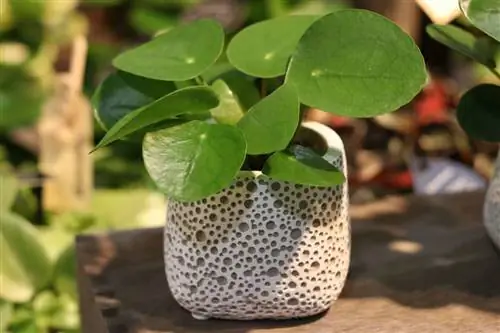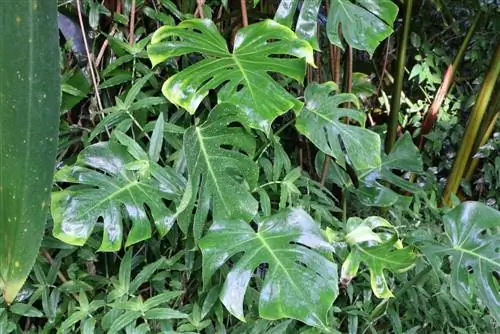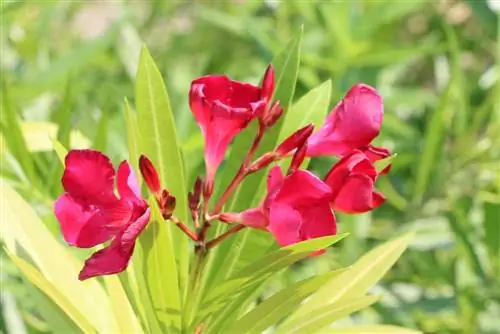- Author admin [email protected].
- Public 2023-12-17 03:39.
- Last modified 2025-01-24 12:45.
The UFO plant is one of the plants that is easy to propagate, among other things. via offshoots. This form of propagation is probably the most successful and can be easily carried out even by beginners.
offshoot propagation
In general, the Pilea, also known as the belly button plant, Chinese money tree or Glückstaler, can be propagated all year round. However, the best time is in spring, around March to May, when it needs to be repotted anyway. In this form of propagation, a distinction is made between two types of offshoots. There are the so-called Kindel, which sprout from the roots at some distance from the mother plant, and those that grow directly on the trunk of the Pilea. Propagation takes place in several steps:
Cutting offshoots
You have to pay attention to whether these are rooted children or offshoots without roots:
Rooted Kindles
Offshoots or seedlings that sprout from the soil next to the mother plant are particularly suitable for growing young plants. They already have their own roots, so the rooting phase is usually not necessary. You get practically full-fledged plants. This makes growth easier and faster.
- don't cut from the mother plant too early
- Seedlings should be large and strong enough
- have at least five fully formed leaves
- be at least four, preferably six to seven centimeters tall
- the bigger and more developed, the better their chances of survival
- Carefully remove the mother plant and seedlings from the pot
- Damage the roots as little as possible
- loose loose soil from the bale
- expose desired number of offshoots
- cut off the roots with a sharp knife
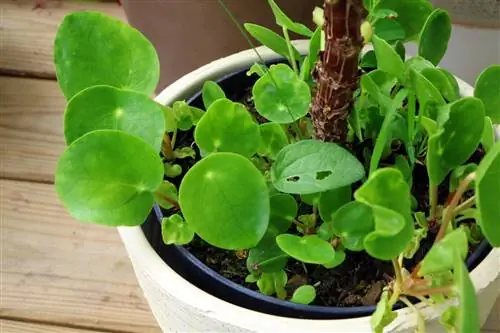
Offshoot without root
They grow directly on the trunk and have no roots. In order to be able to use them for propagation, they should also be large enough and have already developed several leaves. They are cut off directly at the trunk with a sharp knife. This involves cutting under a leaf node. They can then be planted directly or rooted in a glass of water beforehand.
Rooting
Two methods are available for rooting:
In a glass of water
Rooting in a glass of water affects cuttings that are cut without roots. This method is usually just as successful as rooting in soil. The plants often even form roots more quickly here. However, this form of rooting also has a significant disadvantage, because the newly formed fine roots are extremely sensitive and could easily break off later when planting. You should proceed all the more carefully.
- Rooting immediately after cutting
- Put the cutting in the water for a few days
- Water shouldn't be too cold
- ideally use soft or stale water
- change every two days
- Leaves must be above the water
- otherwise there is a risk of rot
- place the whole thing in a bright to partially shaded place
- be sure to avoid the blazing midday sun
- Morning, evening or winter sun no problem
- first fine roots usually after just a few days
In Earth
Freshly cut unrooted cuttings can also be rooted directly in soil. Depending on the number of cuttings, fill one or more small pots with substrate. Above all, it should be loose and well-drained. Then you insert the offshoots about two centimeters deep. The soil is then lightly pressed, moistened and the pots are placed in a bright and warm place in the apartment.
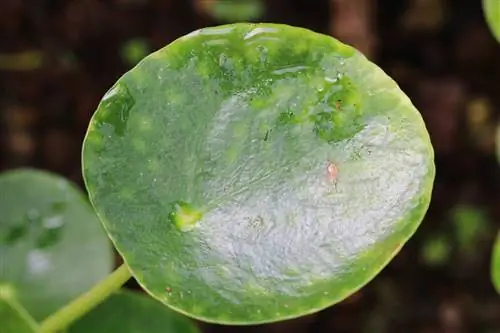
The substrate should always be kept evenly moist and should not dry out at any time. In the best case, roots will have formed after just two to three weeks. If necessary, covering with translucent foil can accelerate root formation.
Tip:
In rooms with sufficient humidity, covering with foil can be dispensed with.
Planting
As already mentioned, rooted children can be planted directly into high-quality substrate. Specimens rooted in a glass of water can be planted as soon as the roots are two to three centimeters long.
- fill pots with soil
- ideally with commercially available potting soil or cactus soil
- or in a mixture of sand and peat
- press a small hollow in the middle of the substrate
- then plant seedlings
- Proceed very carefully to protect the roots
- Press the soil lightly again and moisten it
- place in a bright place with temperatures between 15 and 25 degrees
In the first few weeks after planting, the cuttings need to be watered regularly, about every two to three days. This means they can form many new roots and develop well. Too much moisture should be avoided as this could cause the roots to rot and the plants to die.
Tip:
Placing the plant in a cooler place over the winter can increase the chances of flowers. Compared to the leaves, these are rather inconspicuous.
Create optimal growing conditions
So that the young cuttings can develop into magnificent and he althy plants, they now primarily need warmth and light without direct sunlight, especially during midday. Morning and afternoon sun, however, are not a problem. It should not be cooler than 12 degrees and the substrate should neither be too dry nor waterlogged. If you pot the Chinese money tree regularly, i.e. annually, you can usually avoid fertilizing completely.
Tip:
By the way, the Pilea grows according to the light. So that it grows straight, you should turn it a little every now and then.

